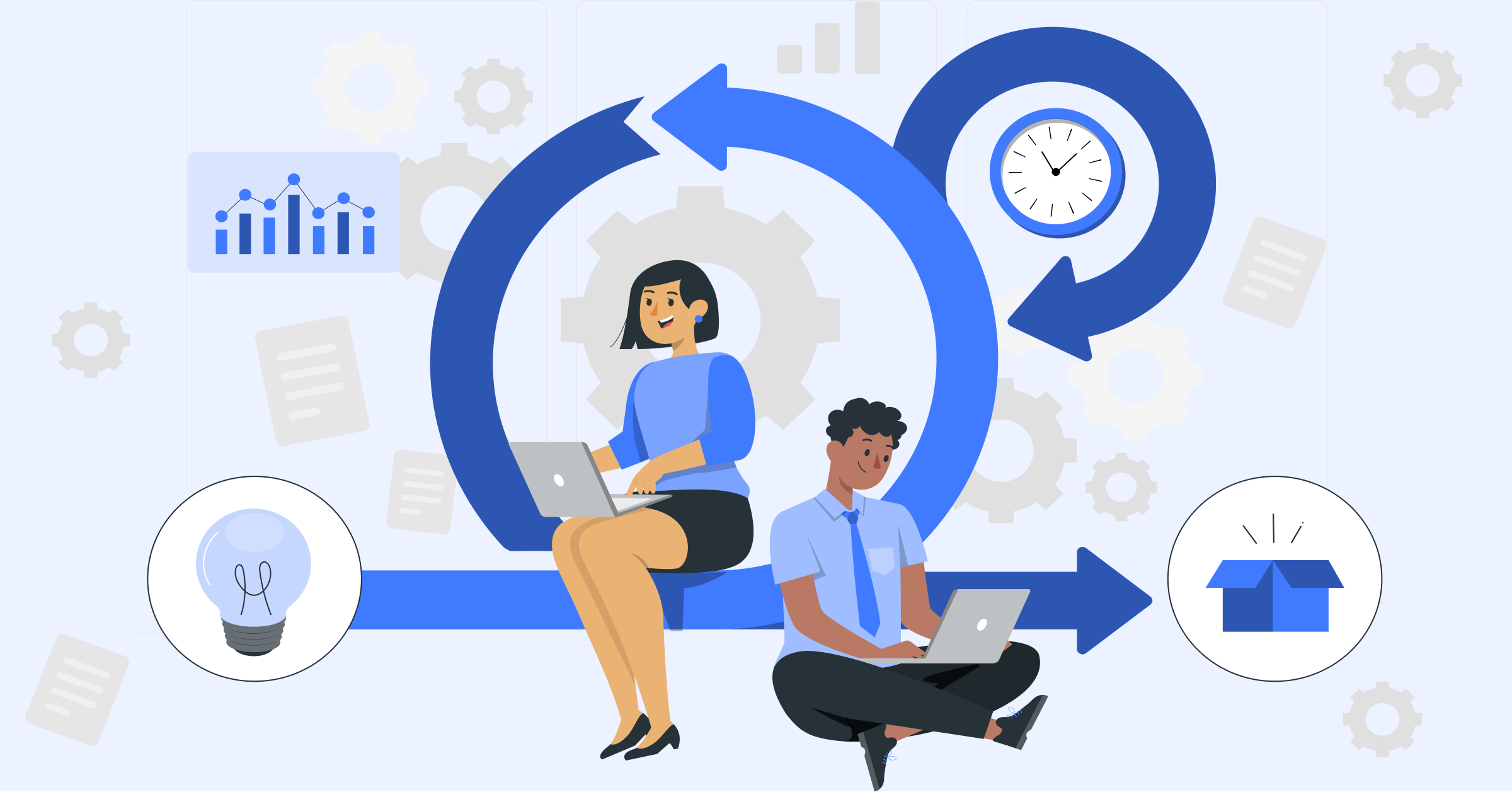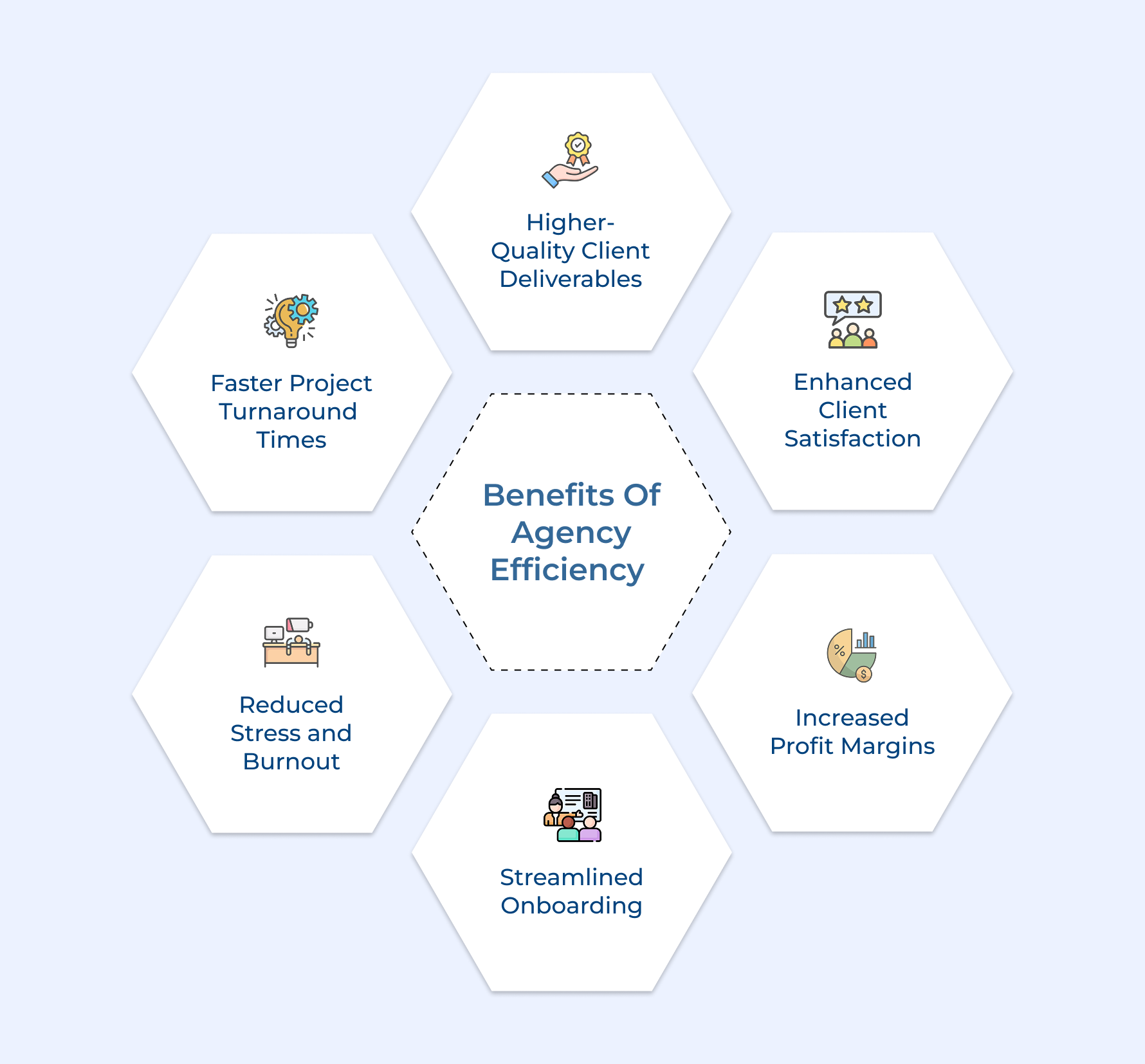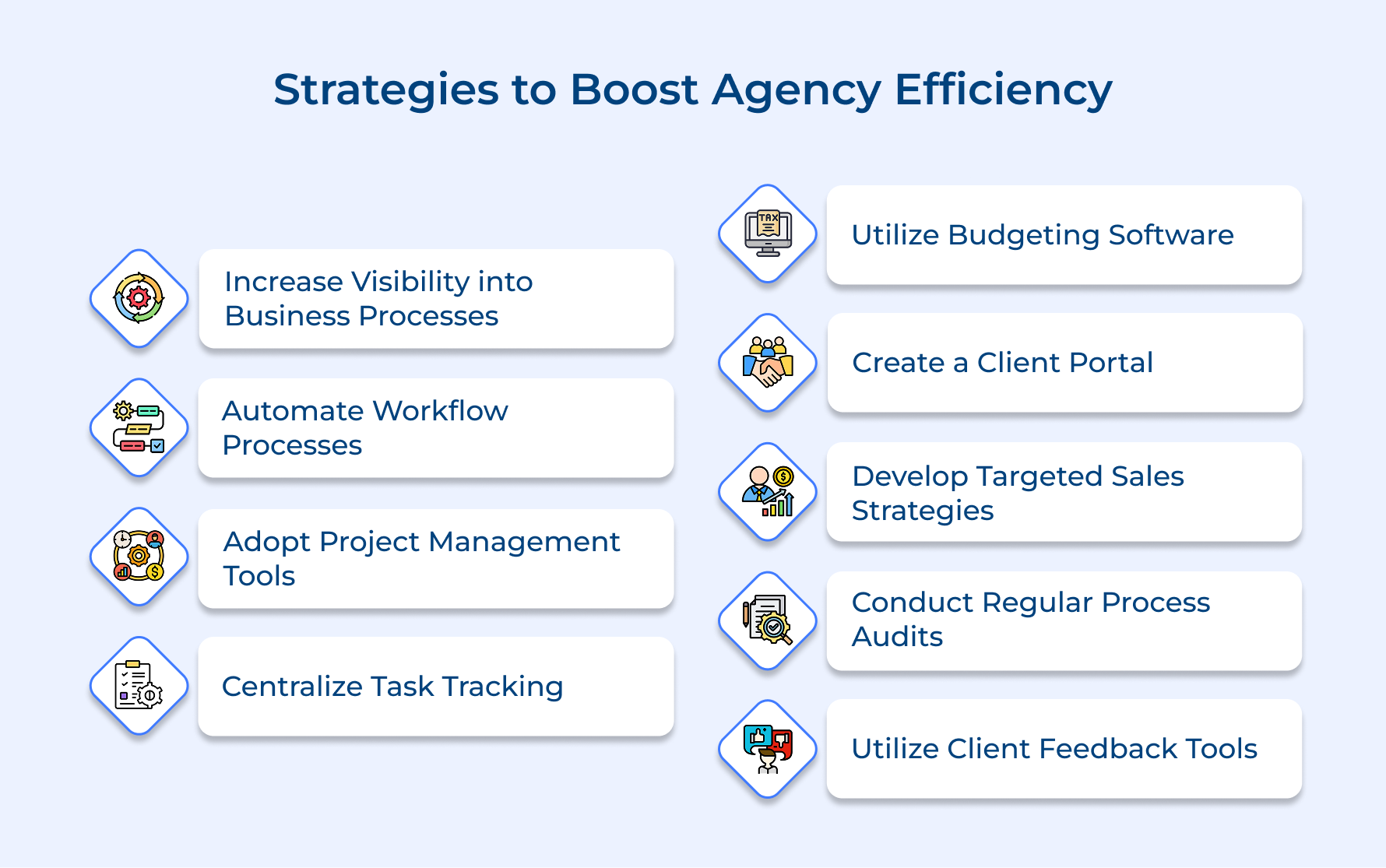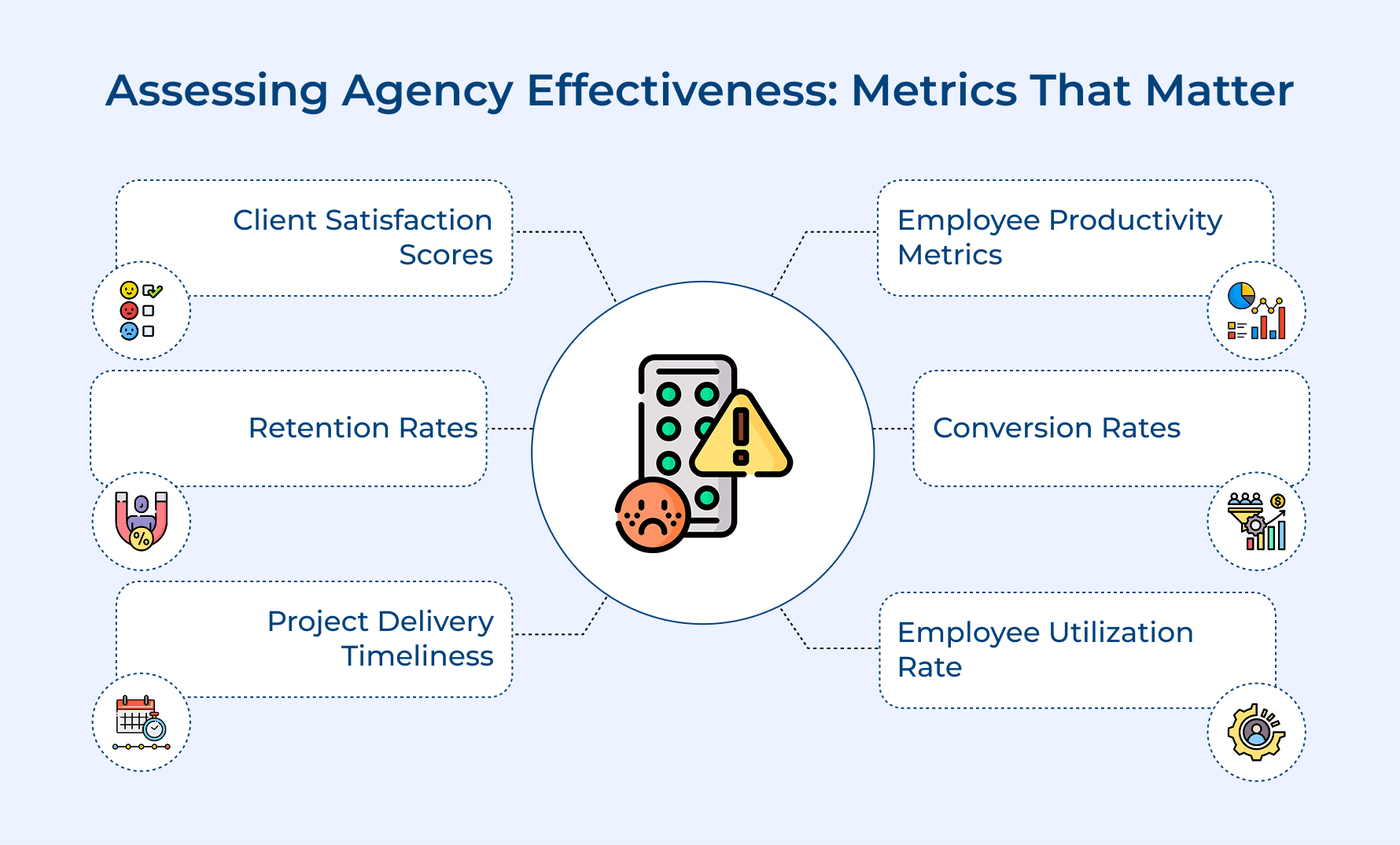Top 9 Strategies to Enhance Agency Efficiency in 2025
- What Exactly is Agency Efficiency?
- What are the Benefits of Agency Efficiency?
- 9 Smart Strategies to Boost Agency Operational Efficiency
- Metrics That Assess Agency Efficiency
- Common Challenges in Improving Agency Efficiency
- Securing Sustainable Success with Enhanced Efficiency
- FAQs about Agency Operational Efficiency

Key Highlights
Many agencies face challenges such as outdated processes, communication breakdowns, and inefficient resource allocation. The repercussions lead to delays, increased costs, and unsatisfied clients that eventually jeopardize long-term growth.
As competition intensifies, agencies must streamline their operations to stay ahead and meet ever-evolving client demands. How to achieve it?
For starters, focusing on operational efficiency enables agencies to optimize workflows and improve service delivery.
Read on to learn key strategies and best practices that help agencies maximize their operational efficiency as well as achieve sustainable success.
What Exactly is Agency Efficiency?
Agency efficiency refers to the optimal use of resources (time & effort) within a marketing, advertising, or creative agency to maximize productivity and deliver high-quality results to clients.
When agencies operate efficiently, they can deliver better results for clients, adapt to changing market conditions, and enhance their reputation in the industry. The process usually involves streamlining processes, minimizing waste, and enhancing overall performance to achieve business goals effectively.
Key objectives:
- Resource optimization: Allocate human and material resources effectively to maximize output as well as minimize waste.
- Time management: Streamline workflows and processes to reduce bottlenecks while also meeting deadlines consistently.
- Cost reduction: Identify and eliminate unnecessary expenses while maintaining service quality.
What are the Benefits of Agency Efficiency?
Agency efficiency leads to improved productivity and enhanced client satisfaction. Here are key benefits that drive long-term success and competitive advantage.
- Higher quality client deliverables: Efficient agencies allocate more resources and time to refining client work. The result is enhanced creativity along with more polished final products. Ultimately, the agency’s reputation and client satisfaction are elevated.
- Enhanced client satisfaction: Streamlined processes enable agencies to meet deadlines consistently, communicate effectively, and exceed client expectations. You build trust and strengthen relationships while increasing the likelihood of repeat business.
- Increased profit margins: Optimizing resource allocation and minimizing waste enables agencies to reduce operational costs while maintaining output quality. Higher profit margins translate to opportunities for reinvestment in talent, technology, and growth initiatives.
- Streamlined onboarding: Efficient agencies develop clear, repeatable processes for integrating new clients and team members. Reducing confusion, accelerating productivity, and ensuring a smooth transition allow both the agency as well as clients to realize value more quickly.
- Reduced stress and burnout: Well-organized workflows in agencies lead to less overtime and better work-life balance. Employees become happier and more motivated, reducing turnover while cultivating a more positive work environment.
- Faster project turnaround times: Efficient agencies complete projects more quickly without sacrificing quality. The ability to deliver results rapidly enhances client satisfaction, allowing for handling more projects simultaneously.
9 Smart Strategies to Boost Agency Operational Efficiency
Implementing targeted strategies can transform workflows and optimize resource allocation. Here are effective approaches that enable agencies to operate at their best.
1. Increase Visibility into Business Processes
Having clear visibility into your business processes helps you spot bottlenecks, inefficiencies, and areas where you can improve.
When agency leaders have this clarity, they can make better data-driven decisions, allocate resources more effectively, and ensure that everyone on the team understands their roles.
Let’s take an example.
Think about a team that struggles to meet deadlines because no one knows who’s doing what. Mapping out the workflow helps everyone see their responsibilities and how they fit into the bigger picture, making it easier to stay on track.
Here are a few ways to enhance visibility:
- Use process mapping tools to visualize workflows.
- Implement dashboards that show real-time metrics on project progress and key performance indicators.
- Hold regular team meetings to discuss how processes are performing and to gather insights.
- Encourage open communication so team members feel comfortable reporting issues or suggesting improvements.
Pro Tip:
Involve team members from all levels when mapping processes. It doesn’t just bring in diverse perspectives but also ensures the maps are accurate and useful.
2. Automate Workflow Processes
Automating mundane tasks helps you minimize human error and free up time for more creative as well as strategic work. Plus, it ensures consistency in how tasks are executed and helps your agency scale as it grows.
Benefits of Automation:
- Reduces manual, repetitive tasks.
- Speeds up task completion.
- Provides better tracking and reporting capabilities.
How do you get started?
- Identify tasks that could be automated, like email responses, social media posting, or generating reports.
- Choose workflow automation tools that can integrate with your existing systems.
- Set up triggers and actions for automated sequences, such as task assignments along with deadline reminders.
The key here is to start small! Begin with low-risk processes to build confidence in the team and work out any kinks before moving on to more complex automation.
3. Adopt Project Management Tools
Project management tools provide a centralized platform for planning, executing, and monitoring projects. They help your team collaborate better, allocate resources efficiently, and keep track of deadlines. Moreover, they give you visibility into project progress, allowing you to spot potential delays early on.
Here’s how to make the most of project management tools:
- Choose a tool that fits your agency’s needs.
- Set up project templates, timelines, and task dependencies.
- Assign roles and responsibilities directly within the tool.
- Use features like Gantt charts for visual planning and time tracking for accurate billing.
Pro Tips:
- Customize the tool to match your agency’s workflow and terminology for easier adoption.
- Integrate it with other software (like time tracking and invoicing) to create a seamless workflow.
- Designate a ‘power user’ on the team to champion the tool and provide support to ensure everyone uses it consistently.
4. Centralize Task Tracking and Team Collaboration
Let’s talk about the importance of centralizing your task tracking and team collaboration. When you do this, you eliminate those pesky information silos, cut down on miscommunication, and ensure that everyone is on the same page.
The centralization not only boosts accountability but also makes handoffs between team members smoother.
Here’s how you can make it happen:
Productive collaboration
Implement a collaborative platform that combines task management, file sharing, and communication features. Think of it as your team’s digital command center!
Streamlined workflow
Create project-specific channels or boards where team members can easily update task statuses, share files, and discuss project details. This keeps everything organized and accessible.
Effective communication
Utilize tagging and notification systems to ensure that relevant team members are always in the loop. No more missed messages!
Systematic updates
Regularly update and maintain the central system to keep it accurate as well as useful for everyone.
Set clear guidelines for how and when to update tasks. Look for integrations that automatically sync information from other tools, like email and calendars, to your central platform. Encourage your team to use the collaboration features for project-related discussions.
5. Utilize Budgeting Software
Budgeting software gives real-time visibility into financial performance, enabling you to make informed decisions about resource allocation, pricing, and profitability. With accurate project costing and budget tracking, you can prevent overruns as well as plan better financially. This not only helps your agency stay healthy but also ensures you’re delivering value to clients.
How to leverage budgeting software effectively?
- Choose software that integrates seamlessly with your project management and time-tracking tools.
- Set up project budgets and track expenses in real time.
- Use forecasting features to anticipate future financial needs.
- Generate regular financial reports for leadership reviews and keep an eye on budget limits to avoid overruns.
Train project managers on using the budgeting software along with implementing an effective agency account management strategy to make informed decisions about resource allocation. Regularly compare actual costs against budgeted costs to improve future project estimates.
6. Create a Client Portal
Let’s say you’re running an ad campaign for a client. Through the portal, they can log in anytime to check how things are moving along. They can see key milestones, view files, approve work, and send you feedback directly.
The setup not only saves time for everyone but also keeps your client in the loop, helping you maintain a strong relationship.
When setting up a client portal, here’s what to keep in mind:
- Make it secure and user-friendly: Create a login where clients can see project updates and approve work seamlessly.
- Add key features: Include things like milestone tracking, file sharing, and messaging. This way, clients can interact with their projects directly.
- Brand it right: Customize the portal’s look to match your agency’s branding for a cohesive experience.
- Stay updated: Keep project details and deliverables fresh so clients always see the latest.
Pro Tips:
- Start with a Client Onboarding Session. Walk clients through the portal to ensure they know exactly how to use it.
- Add credentials for clients to give feedback on the portal itself, so you can improve it to fit their needs.
- Track client engagement with the portal. It reveals which features work best or which could use a little tweaking.
So, instead of emailing back and forth or scheduling update meetings, your clients get everything they need (project updates, deliverables, important documents) right there in one spot.
7. Develop Targeted Sales Strategies
Targeted sales strategies help agencies focus their efforts on the most promising leads and ideal clients.
Imagine you’re launching a new branding service specifically for tech startups. Instead of a generic pitch, you’d create tailored proposals highlighting how your services directly address the branding challenges of tech founders.
This way, you’re speaking their language, addressing their specific needs, and showing your agency’s relevance in their industry. It’s a powerful approach for building rapport and boosting conversions.
To put this into action:
Do Your Research
Research your target audience to pinpoint your ideal client profile. Create detailed buyer personas to sharpen your targeting and tailor your messaging more effectively.
Customize Your Pitch
Use these insights to craft pitches and marketing materials that resonate with each client segment. Share case studies and testimonials to build credibility.
Leverage Tech
Use CRM software to track, nurture, and convert leads effectively. Regularly analyze sales data to refine as well as improve your targeting approach.
8. Conduct Regular Process Audits
Regular process audits are like giving your agency a check-up to spot any inefficiencies or outdated methods that might be holding you back. Think of it as a way to keep everything running smoothly while staying up-to-date with the latest tech and industry standards.
To make the most of an audit:
- Set Regular Review Times. Schedule periodic check-ins on core agency processes.
- Combine data analysis with feedback from your team and clients to get a complete picture of what’s working and what could be improved.
- Map out your current processes and see how they stack up against best practices. Look for bottlenecks or redundancies, then develop a plan to improve and track the impact of any changes.
Involve team members from different departments to get a variety of insights. Use both hard data and qualitative feedback for a balanced view of what’s effective. Focus on the improvements that will make the biggest impact to bring meaningful, lasting change.
9. Utilize Client Feedback Tools
Client feedback tools are crucial for understanding client satisfaction, project success, and areas where you could improve. Through active responses to feedback, you show clients that you’re committed to their success, while also catching potential issues before they become bigger problems.
Regular feedback strengthens relationships, leading to higher retention and even referrals.
Here’s how to put client feedback tools to good use:
- Automate surveys: Send out quick surveys at key project milestones and wrap-ups to get timely feedback.
- Measure satisfaction with NPS: Use Net Promoter Score (NPS) surveys to see how likely clients are to recommend you, giving you a clear snapshot of overall satisfaction.
- Build feedback into the client portal: Make it easy for clients to share thoughts by adding a feedback feature directly in the client portal.
Once you have feedback data, look for trends as well as areas to improve, share your findings with the team, and plan actionable steps for improvement.
Metrics That Assess Agency Efficiency
Measuring effectiveness through key metrics helps agencies identify strengths and weaknesses. Here are important metrics that guide improvements and ensure alignment with business goals.
Client Satisfaction Scores
Regularly measure client satisfaction through surveys or net promoter scores. These metrics provide invaluable insights into client perceptions of your agency’s performance. High satisfaction scores often correlate with client retention and referrals, while low scores signal areas needing improvement.
Retention Rates
Monitor the percentage of clients who continue to work with your agency over time. High retention rates indicate strong client relationships and consistent delivery of value. Low rates may signal issues with service quality or client management.
Project Delivery Timeliness
What is your percentage of projects completed on or before the deadline? Consistent on-time delivery demonstrates efficiency and reliability, key factors in client satisfaction. Late deliveries can strain client relationships as well as impact profitability. Use this metric to identify bottlenecks in your processes and areas needing optimization.
Employee Productivity Metrics
Productivity metrics are all about output per employee, such as billable hours or tasks completed. Higher productivity often translates to increased profitability and capacity to take on more work. Low productivity may indicate inefficient processes, inadequate tools, or employee burnout. The insights help to optimize workflows and support staff.
Conversion Rates
Is the total percentage of your leads or proposals that convert into paying clients high or low? High conversion rates suggest effective sales processes and alignment between agency offerings as well as market needs. Low rates may indicate issues with pricing, proposal quality, or target market fit. Leverage this data to refine your sales approach.
Employee Utilization Rate
Calculate the percentage of employee time spent on billable work versus non-billable activities. Higher utilization rates often correlate with increased profitability. Low rates may indicate inefficient processes or overstaffing. Balance this metric with employee satisfaction to ensure sustainable productivity levels.
Common Challenges in Improving Agency Efficiency
Agencies encounter various obstacles such as resistance to change and inefficient processes. Here are significant challenges that hinder progress toward achieving optimal operational efficiency.
Client Scope Creep
Agencies often face expanding project scopes without corresponding budget increases.
How to fix it?
- Establish clear project boundaries in contracts and implement change request procedures.
- Educate clients on the impact of scope changes and negotiate additional compensation when necessary.
- Regular check-ins and proactive communication can help manage potential scope creep before it becomes problematic.
Ineffective Time Management
Poor time management leads to missed deadlines and reduced productivity.
Ways to fix:
- Implement time-tracking tools to understand how time is spent.
- Train staff on effective time management strategies and use project management software to set realistic deadlines as well as track progress systematically.
Lack of Standardized Processes
Inconsistent workflows across teams or projects result in inefficiencies and quality issues.
Fixes that help:
- Develop and document standard operating procedures for common tasks and projects.
- Create templates and checklists to ensure consistency.
- Regularly update these processes based on feedback and changing needs.
Inadequate Project Management
Poor project management leads to disorganization and missed deadlines.
How to fix it?
- Invest in robust project management software and train team leaders in project management methodologies.
- Assign clear roles and responsibilities, including a dedicated project manager for complex projects.
- Encourage transparent communication about project status and potential roadblocks.
Resource Misallocation
Inefficient distribution of workload and skills mismatch reduces overall productivity.
Fix them through:
- Conducting regular skills assessments and maintaining an up-to-date inventory of team capabilities. Use resource management tools to balance workloads effectively.
- Implement a system for team members to indicate their capacity and expertise.
- Cross-train employees to increase flexibility in resource allocation and consider hiring specialized freelancers for specific project needs.
Securing Sustainable Success with Enhanced Efficiency
Agency efficiency is essential for thriving in a competitive market, as it directly influences service quality, client satisfaction, and profitability. Optimizing processes and resources enables agencies to respond more quickly to client needs as well as maintain a sustainable business model.
Implementing standardized procedures, leveraging technology, and building a culture of collaboration are vital for achieving agency efficiency. Utilizing tools like project management software and automation can streamline workflows, allowing teams to focus on high-value tasks while also enhancing overall performance.
Limit time — not creativity
Everything you need for customer support, marketing & sales.
Neeti Singh is a passionate content writer at Kooper, where he transforms complex concepts into clear, engaging and actionable content. With a keen eye for detail and a love for technology, Tushar Joshi crafts blog posts, guides and articles that help readers navigate the fast-evolving world of software solutions.


